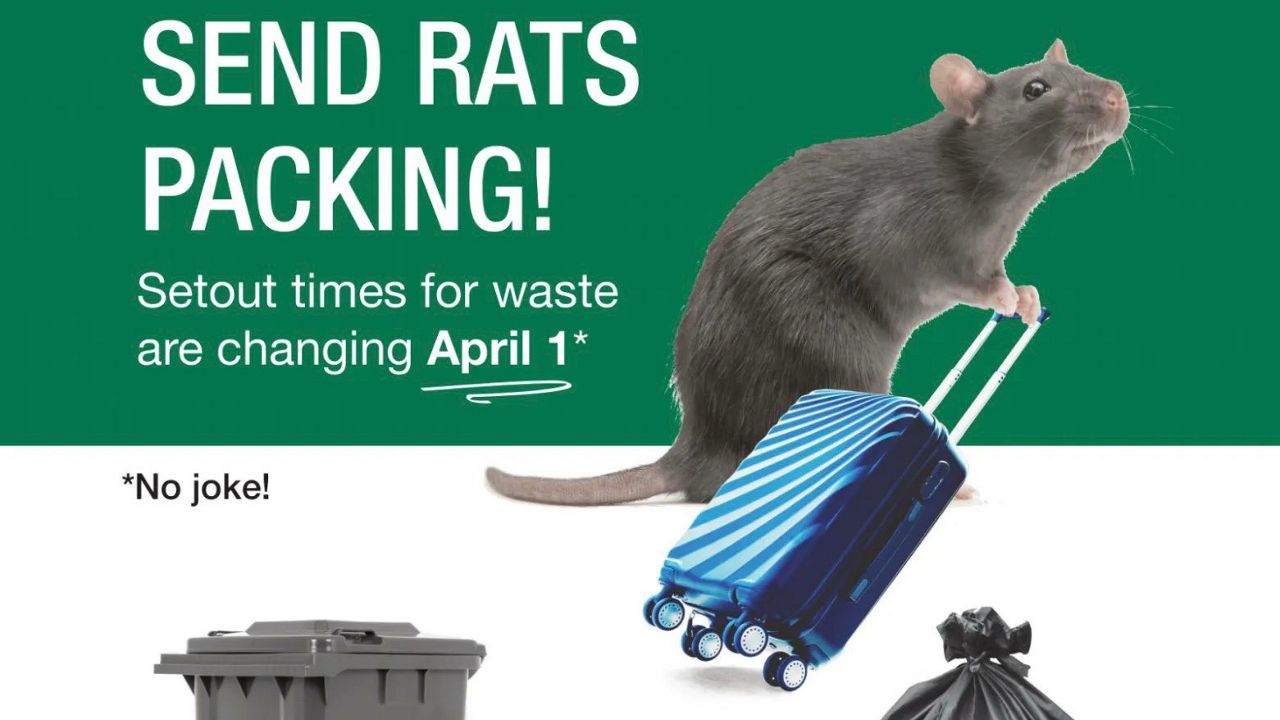For many New Yorkers, rats are the opposite of cute: They’re disease-carrying pests that almost seem to enjoy sprinting out from under a pile of trash to deliver the perfect jump scare.
But what if you gave the rat a teeny little suitcase?
A flier from the city’s sanitation department features such a travel influencer rat, to publicize that beginning Saturday, the earliest time a building can set out its trash for curbside pickup will be 8 p.m. instead of the current 4 p.m. (Or 6 p.m. if the trash remains in a rat-proof plastic bin.)
The rat and its apparent wanderlust have been the subject of social media fawning over the past week. On Wednesday, WNYC radio host Brian Lehrer asked the sanitation commissioner, Jessica Tisch, “Are you worried that the rat on the flier is too cute?” (No, she responded, the point was to get our attention.)
Yet rat experts are wrinkling their noses at the idea that simply shifting the rodent population’s feeding hours will have any effect at all on their population.
“Changing the time? They'll just get together, and they’ll synchronize their watches, and say, ‘Oh, we have to wait ‘til eight o’clock now. No problem,’” said Mike Deutsch, a bug and rodent extermination expert at Arrow Exterminating Co., Inc. with 50 years in pest control.
From the perspective of political rhetoric, it is not a great time to be a rat in New York City. Mayor Eric Adams has made his visceral hatred of rats a centerpiece of his public persona.
“Everyone that knows me, they know one thing: I hate rats,” he told reporters in October, when he first announced the plan to move the window when trash can be put out on the curb. “When we started killing them in Borough Hall, some of the same folks [that] are criticizing us now called me a murderer because I was killing rats. Well, you know what? We're going to kill rats.”
Yet city data from calls reporting rat sightings to 311 suggest that we are living through the roaring rodent ‘20s. Total reported sightings grew from 16,262 in 2020, to 25,010 in 2021, to 26,496 last year. Year-to-date, 2023 rat sightings through the middle of this week rivaled the total through the end of March 2022, suggesting that the rat kings still reign.
It’s not clear what’s driving the rising numbers, experts said, in part because the city does not conduct or sponsor extensive research on rat behavior and biology.
Rat needs, however, are simple, Deutsch said: food, water and shelter.
“Basic principle: If you can eliminate one of those things, you're gonna stress the population, you're going to reduce the numbers,” he said.
This new plan will not help on those fronts, he added, because rats are nocturnal, meaning the vast majority of rats come out to feed at night.
“I don’t know of any experts, any rodentologists or pest professionals, that think it's going to change the rat populations,” said Michael Parsons, a longtime rat researcher and a visiting scholar at Fordham University.
When New Yorkers see a rat during daytime hours, or crawling around the subway, they’re looking at either a rodent pariah that’s been kicked out of its den, or it’s an abnormally daring rat, Parsons said. Any policy that emphasizes rat behavior during daytime hours or in places with high foot-traffic is missing the vast majority of the population.
“‘Pizza Rat’ is the Aaron Judge of rats,” Parsons said, referring to the Yankees’ record-setting slugger. “You’re talking about the extreme, extreme, extreme outlier.”
Parsons and Deutsch said they both supported the purely aesthetic effects of the policy, with city streets hopefully no longer resembling Paris during a historic trash collector strike on a typical Tuesday afternoon.
As long as it doesn’t blow the budget, Parsons said. (Joshua Goodman, a spokesperson for the sanitation department, called the costs of changing trash pick-up routes “minimal,” but added that the effort to make the operational change was “very significant.”)
Parsons bemoaned failed efforts in recent years to curb the rat empire, such as millions spent on mint-scented trash bags (in a contract that brought FBI scrutiny for benefiting the company of a political donor to former Mayor Bill de Blasio). In that case, the rats quickly learned to love the smell of mint, because it meant one thing: food.
“We see a lot of gimmicky things that really have the potential to worsen, not improve, the rat situation,” Parsons said.
Vince Gragnani, a sanitation department spokesperson, said that the change in curbside set-out times for trash will be accompanied by the department’s haulers now shifting about a quarter of all the pick-ups from the 6 a.m. shift back to the midnight shift. That portion of the city’s waste collection will now sit on the sidewalk for about four hours, instead of up to 14 hours, he said.
Yet even shortening the hours on the rats’ trash buffet may have little to no effect, Deutsch said.
“It’s not gonna make a difference,” he said. “The rats will just adapt to the new schedule.”
Parsons has advocated for the city to expand efforts to study rats, put food waste in sturdy containers and pursue science-backed strategies for controlling their population.
He believes that it is ultimately misguided to focus on killing rats over sensibly managing the human waste stream, even if that is the strategy the city is taking for now: The well-publicized job listing for Rat Czar lists “somewhat bloodthirsty” as a desired qualification. At the end of the day, rats produce so many offspring, and so quickly, that we will never be able to eliminate them faster than they reproduce.
“It really wouldn't matter as long as there's still rubbish, and shelter available for that,” Parsons said. “So we don’t want a rat killer.”



